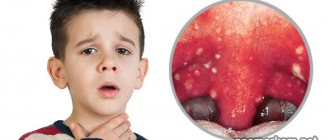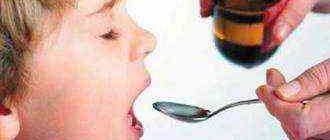Streptococcal infection in the throat is a group of pathologies, the development of which is provoked by a type of pathogenic microorganism, such as hemolytic streptococcus.
These bacteria live in the throat cavity of people. In a normal state of health, they do not manifest themselves in any way. If the body is affected by unfavorable factors from the outside, then the activation of microorganisms of this type can provoke various inflammatory processes.
The pathologies caused by these microorganisms vary. Their location plays an important role in the symptoms and manifestations of infection.
What is streptococcus?
Streptococci look like a regular or slightly elongated ball, do not have flagella and do not form spores. They do not move and live in conditions where there is no oxygen at all.
Looking at them under a microscope, you can see that they always stick together or are lined up in a chain. In nature, they are found in soil, on plants, the body of animals and humans.
Streptococci are resistant to freezing and heating, and their ability to reproduce remains for years.
For the development of a streptococcal colony, a nutrient medium is required: a sweet solution, blood or serum. Such conditions are created in special laboratories to monitor them. When a colony of streptococci occupies a surface, it forms a greenish translucent film.
Causes of streptococcal infections
It is a beta hemolytic streptococcus, it destroys red blood cells - erythrocytes. Streptococci, living in the human body, begin to secrete toxins and poison that have a detrimental effect on the human body. The person begins to get sick and develops weakness, pain, fever and nausea.
Pathogenicity factors:
- Streptolysin is a poison that harms the cells of the heart and blood.
- Scarlet fever erythrogenin is a toxin that dilates capillaries. In scarlet fever it causes a skin rash.
- Leukocidin is an enzyme that destroys immune blood cells (leukocytes), weakens the immune system and it cannot resist infections.
- Neurotoxin and lethal toxin are poisons that cause tissue death.
- Amylase, hyaluronidase, proteinase and streptokinase are enzymes due to which streptococci absorb healthy tissue and fill the human body.
Where streptococci are located, a focus of inflammation appears, a person experiences swelling and pain. Bacteria produce toxins and poison that travel through the body through the blood.
Therefore, with streptococcal infections, a person is always accompanied by general malaise; in severe cases, large-scale intoxication occurs. Vomiting, dehydration, and confusion may occur. Lymph nodes swell near areas of inflammation.
The immune system perceives them as a powerful allergen and begins to produce antibodies.
Autoimmune diseases and complications can become a dangerous consequence:
- rheumatoid arthritis,
- myocarditis,
- pericarditis,
- endocarditis.
Treatment of streptococcus with folk remedies
Important! Before using folk remedies, consult your doctor. Apricot
Apricots have proven themselves well for the treatment of streptococcal infections - apricot pulp should be consumed 2 times a day, morning and evening, on an empty stomach. For skin lesions, the skin can also be rubbed with apricot pulp
Apricot. Apricots have proven themselves well for the treatment of streptococcal infections - apricot pulp should be consumed 2 times a day, morning and evening, on an empty stomach. For skin lesions, the skin can also be rubbed with apricot pulp.
Black currant. Blackcurrant berries not only contain a high dose of vitamin C, but are also a natural antibiotic. To use these berries as a remedy, you need to eat 1 glass of them after each meal.
Chlorophyllipt. As an alcohol and oil solution, it can be used to treat diseases of the ENT organs. The alcohol solution is used as a rinse for the nasal cavity and throat; the oil solution is instilled into the nose and lubricated the tonsils. The course of treatment is 4-10 days.
Rose hip. Pour 500 water over the rose hips, bring the product to a boil, boil for about 5 minutes and set aside for several hours to infuse. Drink 150 ml of the prepared decoction twice a day. An increase in effectiveness was noticed when using this remedy simultaneously with the use of apricot puree.
Onion and garlic. These products are natural antibiotics against various infections. To use onions and garlic as a remedy, you do not need to prepare anything special, you just need to eat them along with other foods, at least a couple of times a day.
A series. Grind thoroughly and pour 400 ml of boiling water over 20 g of dry string, cover the container and leave to infuse. When the product has cooled, strain it well and take 100 ml, 4 times a day.
Streptococcal infection
It appears on the skin and appears on the skin of the neck, face and hands, and affects the respiratory organs.
Causes
The most common types of streptococcus are alpha (green), beta, gamma (non-hemolytic). Beta streptococci are dangerous to health, and viridans and non-hemolytic ones do not destroy red blood cells, although they feed on humans, they will not cause you to get a serious disease.
Group A streptococcus
Hemolytic streptococcus is a gram-positive bacterium belonging to the lactobacilli family. They are round in appearance and reproduce in pairs or form colonies.
Normally, they are found in the body of every person, but they begin to become active with weakened immunity or hypothermia. Hemolytic streptococci are located on the mucous membranes of the nose and throat, in the respiratory tract and genitourinary organs, and large intestine, then enter the bloodstream and begin to affect various organs.
Group A streptococci cause severe infectious diseases: pneumonia, scarlet fever, pharyngitis, rheumatism, endocarditis, postpartum sepsis.
Group A streptococcus is treated with antibiotics: penicillin, oxacillin, cephalosporin, erythromycin. They change and are resistant to some medications, so the doctor selects the medicine individually. Treatment with antibacterial agents is not always required.
In some people, the immune system fights off the infection on its own. After suffering from the disease, a person’s body develops type-specific immunity against this pathogen.
To prevent streptococcal infection from entering the body, the following precautions should be taken:
- Do wet cleaning regularly and ventilate the room more often,
- do hardening,
- lead a healthy lifestyle, give up bad habits,
- treat your skin with antiseptics more often,
- eat balanced and healthy,
- During the acute respiratory infection epidemic, wear special masks, sanitize dishes and all surfaces.
If you follow all preventive measures, then you can avoid infection with hemolytic streptococcus. The cause of the disease may be communication with the patient or his things that you decide to use. Most often, these bacteria enter the body through the mucous membrane of the respiratory tract.
Bacteria can settle in stale products, expired dairy and meat. The infection enters the skin through scratches, abrasions or an insect bite. A pregnant woman can infect her unborn child.
How to fight the disease
If streptococcus is detected in the throat of a child, Komarovsky E.O. gives the following advice.
When a child is diagnosed with a purulent type of sore throat, which is caused by streptococcus, therapy to eliminate it must necessarily include antibiotics.
To treat infections of this type, antibacterial drugs from the penicillin series are used. They have the greatest effect. Streptococci do not develop strong resistance to medications.
The daily dose of the drug used can only be determined by the attending medical professional. It will depend on the age of the patient.
An important point in therapy is its continuity and completeness. You must take the prescribed medications for at least a week.
In no case should you stop taking medications when the first signs of relief occur.
In addition to antibacterial agents, the specialist gives the following recommendations:
- in order to normalize body temperature, it is necessary to use drugs that reduce fever - paracetamol or ibuprofen;
- to restore strength it is necessary to ensure strict bed rest;
- To reduce symptoms, you need to use local medications - tablets or solutions;
- the patient should drink warm fluids in large quantities;
- The patient should eat liquid food to reduce pain during swallowing.
Dr. E.O. Komarovsky considers any herbal decoctions and soda or saline solutions useless in the treatment of tonsillitis. Therapy carried out only with their help is not able to solve the problem.
Such rinses will only help clear the throat of mucus and reduce pain. The same effect is observed when using different throat tablets.
It is important to understand that this method only treats sore throat caused by bacteria. It is impossible to cure a viral infection with antibiotics.
It is important to start treatment of sore throat in a timely manner.
Antibiotics should be started no later than nine days after illness. In this case, therapy started on the third day of the disease helps to increase immune protection against streptococcus in the future.
If the condition is critical, then treatment should be started immediately.
The human body constantly contains a fairly large number of bacteria that are opportunistic in nature. Streptococci are one of these microorganisms.
When the protective forces of the immune system are reduced or when infected from a sick person, the bacteria living in the body are activated and begin to actively increase in number.
Streptococcus in a child's throat
People with reduced immunity are primarily susceptible to infection with streptococcus - pregnant women, children, and the elderly.
Symptoms:
- The child’s body temperature rises to 40°,
- there is a severe pain in the throat and it intensifies when swallowing,
- cervical lymph nodes enlarge,
- the child begins to feel severely ill and is accompanied by weakness,
- the tonsils swell and become convex, a white coating appears on them, it can be in the form of a cobweb or dotted,
- the child gets hot, then begins to shiver,
- when opening the mouth there is pain, the occipital muscles are inactive,
- headache, nausea and loss of appetite.
Summary
Streptococci provoke the development of various pathologies in the throat in children. Symptoms in each individual case are determined by the specific disease.
Streptococcus in a child's throat is treated with antibiotics from the penicillin series. Therapy must be carried out under the supervision of an experienced specialist.
It is important to start therapy to eliminate the infection in a timely manner. An untreated infection or incorrect treatment can cause various complications affecting the heart and kidneys. Otitis media and sinusitis may be triggered.
Viridans streptococcus
It represents a heterogeneous group of alpha-hemolytic streptococci and is the causative agent of infective endocarditis.
Viridans streptococci are present in the normal microflora of the oral cavity: on teeth and gums, some cause caries.
With minor injuries to the oral mucosa (during eating or brushing teeth), they enter the bloodstream and attach to the endothelium. Found in sinusitis and liver brain abscess.
What is dangerous streptococcal throat infection and how to treat it
Streptococcal throat infection is a group of pathologies that develop under the influence of hemolytic streptococcus. From birth, a person interacts with the world around him, so streptococcus in the throat is considered commonplace.
Causes of pathology
Streptococcal throat infection is a group of diseases caused by hemolytic streptococcus
In adults, the main cause of streptococcal infection can be bad habits, which severely injure the oral mucosa and make it susceptible to the disease.
There are some factors that increase the likelihood of streptococcal throat infections:
- penetration of juice from the stomach into the esophagus and pharynx, that is, heartburn
- long-term treatment with glucocorticosteroids
- undergoing chemotherapy
- immunodeficiency states
From the video you can learn how to distinguish a viral infection from a bacterial one:
In childhood, the infection can enter the body through contact with the mucous membranes of adults who are carriers of bacteria. In most cases, streptococcal infections occur in children born prematurely, in whom the mechanism for obtaining maternal antibodies is disrupted. Infection of children at any age can occur through airborne droplets from coughing or sneezing, as well as through prolonged contact with a sick person.
Symptoms
Body temperature with staphylococcal infection can reach 39-40 degrees
At an early age, you may notice the appearance of the following symptoms in a child:
- nausea and vomiting;
- mucus from the nasal cavity is yellow-green in color;
- rise in body temperature;
- loss of appetite or its complete absence;
- irritability and moodiness;
- constant crying.
When examining a patient, the doctor notices very reddened tonsils and the appearance of pustules on the mucous membrane.
In adults, streptococcal tonsillitis can be severe and be accompanied by the appearance of the listed symptoms. The main complaints of patients are nausea, weakness and low-grade fever. In addition, pain in the throat on both sides, swelling of the face and enlarged lymph nodes are disturbing.
Possible complications
The infection can trigger the development of bronchitis or pneumonia
Mostly complications develop with streptococcal tonsillitis and, especially, in people with reduced immunity.
Early complications that appear a few days after the onset of infection are:
Several weeks after an apparent recovery, late complications may develop, which are associated with the lack of antibacterial therapy or non-compliance with the course of prescribed treatment. Patients may develop:
Diagnosis and methods of eliminating infection
To determine the nature of the infection, you need to take a throat swab
Another way to determine streptococcal infection is to detect antibodies in a person’s blood. Such a study is resorted to only if the streptococcal infection does not affect the symptoms, but it is necessary to determine the carriage and select an effective treatment.
Treatment of streptococcal infection is carried out by the doctor whose area of responsibility is the focus of the inflammatory process.
Treatment of streptococcal infection can be carried out using the following antibacterial drugs:
Treating streptococcal infection with antibiotics
The most effective topical medications are:
Treatment of streptococcal infections in childhood is carried out using antihistamines such as Zodak, Cetrin and Claritin. In addition, a prophylactic intake of vitamin C is prescribed, which helps strengthen the walls of blood vessels and improves immunity.
Traditional methods of treatment
You can gargle using both medicinal and folk remedies.
For a speedy recovery, the patient is recommended to combine basic therapy for streptococcal infection with traditional medicine recipes.
It is important to remember that it is unlikely that it will be possible to eliminate a streptococcal infection using traditional medicine alone, so you should not refuse the prescribed antibacterial treatment. It is possible to get rid of the pathology only with an integrated approach to treatment and mandatory compliance with all the specialist’s recommendations
Lara says
Streptococcal infection symptoms
Symptoms are varied and depend on the location of the pathological process.
- Scarlet fever. A pinpoint rash appears on the body, the body temperature rises sharply, the tonsils become inflamed and the body becomes intoxicated. Weakness, chills, severe headache appear, and within 12 hours a rash appears on the upper body and hands. The peak of damage after infection occurs on the third day. Symptoms begin to subside after an exacerbation after three days. Treatment should be started immediately. In case of severe scarlet fever in a child, treatment is carried out in a hospital. Is it possible to treat scarlet fever in a child at home? Your attending physician will be able to answer this question after examining your child.
- Sore throat is an inflammatory process that most often affects the palatine tonsils. Develops when a person has immunity from scarlet fever. With unqualified treatment, the heart and kidneys can be affected. The reason is favorable conditions in the human body: a reduced immune system and hypothermia of the body.
A streptococcal infection enters the larynx on the mucous membranes and begins to develop very quickly. It can penetrate the tissue that surrounds the tonsils and cause tonsillitis, and if it enters the blood, it will cause sepsis.
How to cure streptococci
Streptococcal infections are treated by an otolaryngologist. Before prescribing a course of therapy, the doctor examines the patient and takes urine and blood tests, as well as a swab from the throat and nose to identify the exact type of pathogen.
Standard tests for streptococcus take an average of five days. But since the acute process does not allow waiting long, the doctor prescribes preliminary treatment for the infection, using mainly antibacterial therapy.
Staphylococcus and streptococcus in the throat require treatment with antibiotics, but for a quick recovery, other medications are also used, as well as traditional medicine methods to relieve unpleasant symptoms.
To cure streptococcus in the nose and throat, antibiotics are prescribed
Drug treatment
To cure streptococcus in the nose and throat, antibacterial drugs must be prescribed, which are selected depending on the causative agent of the disease. Usually drugs from the group of macrolides and penicillins are offered, but if the patient’s condition does not improve within 2-3 days, they resort to the help of stronger drug groups - tetracyclines, cephalosporins and aminoglycosides.
List of medications for the treatment of streptococci
| Group of drugs | Purpose | Examples of drugs |
| Penicillins | Destroying pathogenic microflora in the body. | Ampicillin, Oxacillin, Amoxicillin |
| Macrolides | Azithromycin, Erythromycin | |
| Cephalosporins | Cephelim, Cefuroxime, Cefotaxime | |
| Lincosamides | Klimitsin, Neloren, Lincomycin, Dalatsin | |
| Local antibacterial agents | Destruction of bacteria locally (in the throat, nose) | Grammidin Neo, Bioparox, Strepsils, Septolete. |
| Antiseptic solutions | Eliminating infections, preventing further spread of the disease. Used for irrigation of the nasopharynx. | Miramistin, Chlorhexidine, Hexoral |
| Immunomodulators | Restoring and strengthening the immune system, counteracting bacteria, improving general condition. | Local and systemic: Ingavirin, IRS-19. Natural: echinacea, eleutherococcus, rose hips |
| Vitamins | Restoring and strengthening the immune system. | Supradin, ascorbic acid |
| Analgesics | Relieving pain in the head and throat, relieving symptoms of intoxication. | Tempalgin, Analgin |
| NSAIDs | Reducing temperature, relieving pain, relieving inflammation | Ibuprofen, Ketorol, Paracetamol |
| Mucolytics | Improving the discharge of thick sputum during a wet cough | ACC, Ambroxol, Mucaltin |
| Vasoconstrictor drugs | Relieving nasal congestion, normalizing breathing. | Farmazolin, Noxprey |
| Expectorants | Stimulating the discharge of sputum, clearing the lungs and larynx of mucus. | Codelac, Sinekod, Bronchium |
| Probiotics | Restoration of microflora after antibacterial therapy. | Bifiform, Linex, Bifidumbacterin |
| Antihistamines | Prevention of allergic reactions when taking antibiotics. | Cetrin, Suprastin, Claritin |
During the period of therapy, the patient is recommended to maintain the correct drinking regime, stay in bed, and select a gentle and fortified diet that excludes spicy, hard and sour foods.
Traditional methods
Chamomile decoction is a folk remedy for the treatment of streptococcal infections.
Folk remedies will not help get rid of streptococcal infections in the nose and throat, therefore they are used as an auxiliary therapy to alleviate the patient’s condition and relieve negative symptoms.
To remove bacteria in the throat, use antiseptic rinses with alcohol tinctures of calendula, eucalyptus, and chamomile.
And to boost immunity and improve the patient’s condition - infusions and decoctions of echinacea root, calendula, chamomile, rose hips, and raspberry leaves.
Treatment in children
In children, treatment of streptococcus in the throat and nose is not fundamentally different from treatment tactics in adults.
The dosage of antibiotics for children should be reduced, and instead of artificial immunomodulators, folk remedies should be used to increase the body's defenses.
Dr. Komarovsky advises that if a streptococcal infection is detected in a child, immediately begin treatment. Delay can cause dangerous complications for the baby and even lead to death.
If complications develop due to streptococcus, the child should be urgently hospitalized and subsequent treatment should be carried out in a hospital setting.
Diagnostics
To detect the presence of streptococcus, it is necessary to take blood and urine tests. To determine the type of pathogen, a bacteriological examination should be carried out (smear from the skin, tonsils and sputum).
Additionally, they can take a smear from the vagina and mucus from the urethra. The patient’s symptoms and tests will help the doctor make the correct diagnosis and prescribe appropriate treatment.










